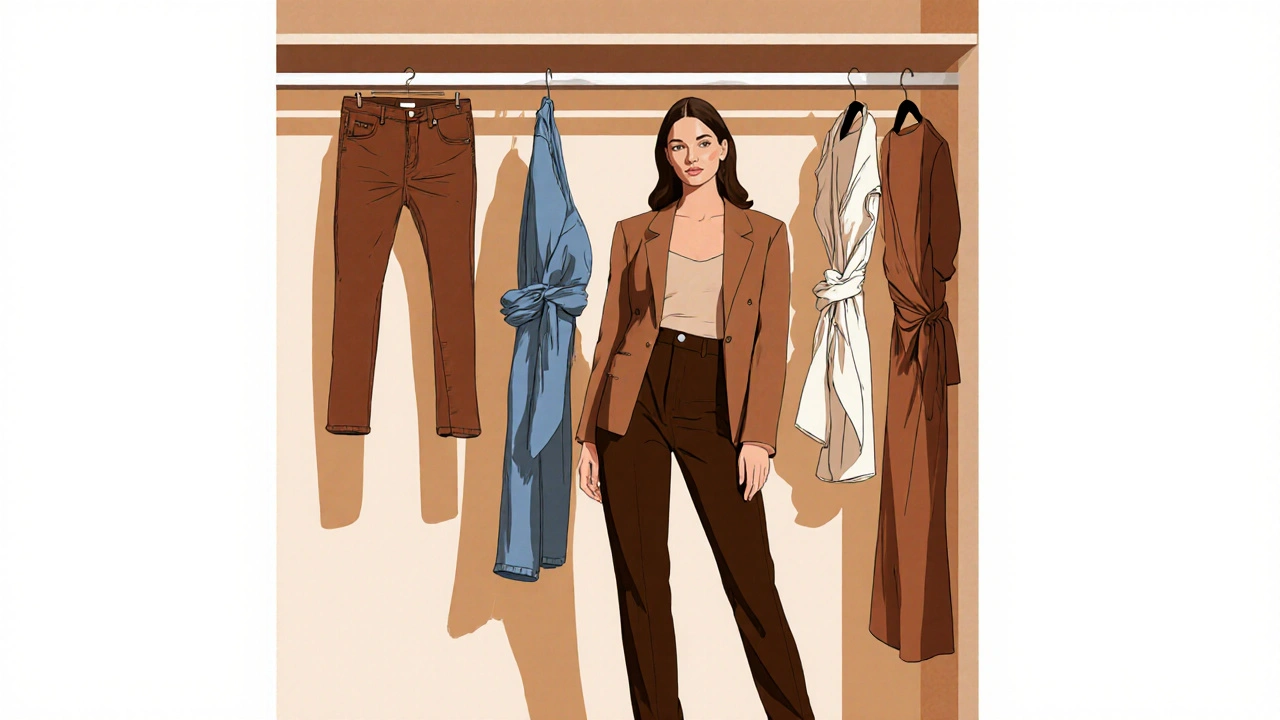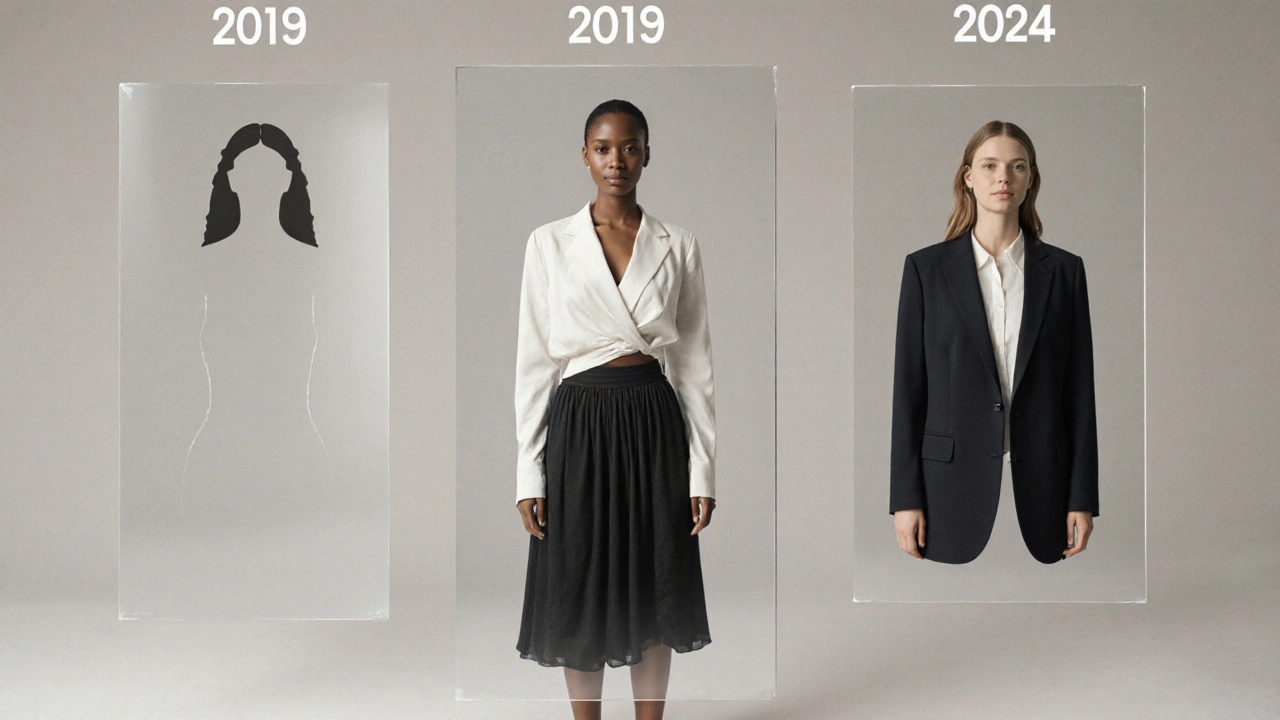Most people don’t realize how often their body shape changes - and how badly their wardrobe suffers because of it. You might have bought that dress five years ago because it hugged your waist just right. Now, it bunches at the hips. Or maybe you lost weight and your favorite jeans hang loose like tents. Your body isn’t broken. Your clothes just haven’t caught up.
Your Body Isn’t Static - Your Clothes Shouldn’t Be Either
Your body changes with age, pregnancy, stress, illness, fitness routines, or even just time. That’s normal. What’s not normal is clinging to clothes that no longer fit your shape because you’re afraid to admit it’s time to let go. A 2023 study from the American Council on Exercise found that over 68% of women experience noticeable body shape shifts between ages 30 and 50 - mostly in the waist, hips, and bust. Men aren’t immune either; muscle loss and fat redistribution start as early as 35.
Ignoring these changes doesn’t make you look better. It makes you feel uncomfortable, out of sync, and sometimes even invisible in your own skin. The goal isn’t to chase a past version of yourself. It’s to dress the person you are today - confidently, comfortably, and without guilt.
Recognizing the Common Body Shape Shifts
Not all body changes are the same. Here are the most common silhouette shifts people experience:
- From Hourglass to Pear: Hips and thighs gain more volume while the waist stays the same or shrinks. Often happens after pregnancy or with hormonal shifts.
- From Pear to Rectangle: Loss of curve in hips and bust, especially after weight loss or menopause. Shoulders and torso become more even.
- Waist Expansion: Belly fat increases due to stress, slower metabolism, or reduced activity. The classic “middle age spread.”
- Bust Changes: Breasts can grow, shrink, or lose firmness - especially after breastfeeding, weight loss, or aging.
- Arm and Upper Back Softening: Muscle tone decreases, leading to looser skin. Common after 40, especially if strength training drops.
Knowing which shift you’re experiencing helps you pick the right fixes. A dress that flatters a pear shape won’t work for a rectangle. A high-waisted pant that hides a soft waist won’t help if your problem is sagging arms.
What to Do When Your Clothes Don’t Fit Anymore
Don’t throw everything away. Don’t hoard it either. Start with a simple three-step process:
- Sort by Fit, Not Sentiment: Take everything out. Try on each piece. If it pulls, gapes, bunches, or feels tight in the wrong places - set it aside. If it fits like it was made for you today - keep it. Let go of the “someday” myth. That day rarely comes.
- Identify Your New Shape: Stand in front of a full-length mirror. Look at your shoulders, waist, hips, and thighs. Where do you carry weight now? What’s your most flattering silhouette? Take a photo. Compare it to one from five years ago. You’ll see the difference clearly.
- Build Around What Works: Keep the 20% of clothes that still fit well. Use them as your foundation. Then, buy new pieces that complement your current shape - not your old one.
For example, if your waist has expanded but your hips stayed the same, focus on tops with structured draping or A-line cuts. If your bust has decreased, avoid overly loose V-necks - they can make you look smaller than you are. Instead, try soft scoop necks or slight ruching that adds subtle volume.

Wardrobe Essentials for Changing Silhouettes
Here’s what actually works for most body shape transitions - no fluff, no trends, just real solutions:
- High-Waisted Pants with Stretch: They smooth the midsection without squeezing. Look for fabrics with at least 5% spandex. Brands like Madewell, Eileen Fisher, and Universal Standard make cuts designed for soft waists.
- Structured Blazers: A well-tailored blazer draws attention upward and creates a clean line from shoulder to hip. It hides belly bulge and adds polish without needing to lose weight.
- Wrap Dresses and Tops: The V-neck and adjustable tie create a flattering shape regardless of where your body has changed. They work for pear, rectangle, or apple shapes.
- Dark, Flowy Skirts: A-line or maxi skirts in lightweight fabrics (like viscose or rayon) skim over hips and thighs without clinging. Avoid stiff materials - they highlight bulk.
- Layering Pieces: Lightweight cardigans, open vests, and longline tunics help balance proportions. They add coverage without bulk.
Don’t underestimate the power of fit adjustments. A good tailor can take in a waist, shorten a sleeve, or raise a hem for under $30. That’s cheaper than buying a whole new outfit - and way more sustainable.
What Not to Buy (And Why)
Some clothing trends are designed for a body you no longer have. Avoid these:
- Low-Rise Jeans: They dig into soft bellies and create unflattering bulges. High-waisted is non-negotiable now.
- Body-Con Dresses Without Stretch: If it doesn’t move with you, it’ll fight you. Look for knits with give, not stiff spandex.
- Overly Baggy Everything: Loose clothes don’t hide shape - they amplify it. Aim for intentional flow, not sloppiness.
- Shapewear as a Permanent Fix: It’s a temporary tool, not a wardrobe staple. If you’re relying on it daily, you’re masking the problem instead of solving it.
The key is balance: not too tight, not too loose. Clothes should support your shape, not fight it.

Shopping Smart When Your Size Keeps Changing
You don’t need to buy a whole new wardrobe at once. Start small:
- Buy one new top and one new bottom that work together. Build from there.
- Shop for fit, not size tags. A size 12 in one brand might be a 14 in another. Look at measurements, not numbers.
- Look for brands that offer extended sizing with thoughtful cuts. Universal Standard, Lane Bryant, and Eileen Fisher design for real bodies, not runway models.
- Use virtual try-on tools. Many sites now let you upload your measurements and see how clothes will fit before buying.
- Buy secondhand. You’ll find high-quality pieces at lower prices - and avoid the pressure of “new” trends.
And remember: your size doesn’t define your style. You can look polished, modern, and put-together at any size - if the clothes are chosen with intention.
When Your Body Changes Again - And It Will
Life doesn’t stop. Your body will change again. Maybe you’ll gain muscle. Maybe you’ll lose weight. Maybe you’ll go through another hormonal shift. That’s okay. The goal isn’t to lock in a perfect look forever. It’s to build a flexible wardrobe that adapts with you.
Keep a running list of what works: “I love this wrap top because it hides my belly and makes my shoulders look broad.” Or: “These high-waisted pants don’t dig in, and they pair with everything.” When your shape shifts again, you’ll know exactly what to look for.
Style isn’t about being thin. It’s about feeling like yourself - even when yourself changes. The right clothes don’t hide your body. They celebrate it, right where it is today.
Final Thought: You’re Not Behind - You’re Evolving
There’s no timeline for when your body should look a certain way. No rule says you have to fit into your old jeans. No law says you need to match your college photos. You’re not falling behind. You’re moving forward.
Every change in your silhouette is a chapter, not a failure. And your wardrobe? It should be your ally - not your critic.
How often should I reassess my wardrobe for body shape changes?
Reassess every 6 to 12 months, or anytime you notice consistent discomfort in your clothes - like pulling at the waist, gapping at the shoulders, or needing to constantly tuck in tops. If you’ve lost or gained 10+ pounds, or gone through pregnancy, menopause, or a major lifestyle shift, it’s time to take stock. Your body changes slowly, but your clothes don’t adapt on their own.
Can I still wear trends if my body has changed?
Yes - but adapt them. Oversized blazers? Try them belted at the natural waist. Wide-leg pants? Choose a high-rise version with a slight taper. The trend isn’t the problem - the fit is. Look for versions designed for fuller hips, softer waists, or fuller busts. Many brands now offer “curvy,” “petite,” or “maternity-friendly” lines that work for post-change bodies too.
What if I’m losing weight but still feel like I look the same?
That’s common. Weight loss doesn’t always mean shape change - especially if you’re losing fat but gaining muscle, or if your body holds weight in places you can’t control. Focus on how clothes fit, not the scale. If your shoulders look broader or your arms are firmer, update your tops. If your waist is still soft, keep high-waisted bottoms. Your body is remodeling - your wardrobe should reflect the renovation, not the blueprint.
Should I buy clothes in my old size “just in case”?
No. Storing clothes that no longer fit keeps you stuck in the past. It’s emotional clutter. You’re not going back. Even if you lose more weight, your body shape won’t look the same as it did five years ago - and your style shouldn’t either. Invest in clothes that fit your current shape, not your old one.
How do I dress for different occasions when my body keeps changing?
Keep a few go-to pieces that work for every event: a great blazer, a wrap dress, dark tailored pants, and a neutral knit top. These are your foundation. Then, add one statement piece per season - a bold color, a new texture, a pair of interesting shoes. That way, you always look intentional, even if your body isn’t the same as last year. Confidence comes from consistency in style, not consistency in size.


Write a comment